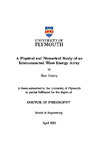A Physical and Numerical Study of an Interconnected Wave Energy Array
| dc.contributor.supervisor | Greaves, Deborah | |
| dc.contributor.author | Howey, Ben | |
| dc.contributor.other | School of Engineering, Computing and Mathematics | en_US |
| dc.date.accessioned | 2020-06-19T13:26:01Z | |
| dc.date.available | 2020-06-19T13:26:01Z | |
| dc.date.issued | 2020 | |
| dc.date.issued | 2020 | |
| dc.identifier | 10175396 | en_US |
| dc.identifier.uri | http://hdl.handle.net/10026.1/15773 | |
| dc.description.abstract |
Key to the progression of the wave energy extraction sector is reducing capital costs whilst maintaining or improving energy extraction efficiency. To achieve this, multiple devices in farm configurations, known as arrays, are likely to be developed. Mooring and anchorage systems of large scale arrays have been highlighted as notable contributors to high structural costs. To minimize the number of anchors required, and thus the cost, one option is to interconnect devices within the arrays. The implication on array performance and line tension of this mooring design needs to be understood to realize the true possibility for cost reduction. Large scale physical tests were performed in the COAST Laboratory at the University of Plymouth. An array of five individually moored oscillating water column type wave energy converters (WEC) were initially tested in operational and extreme conditions, followed by four interconnected designs of reducing levels of interconnectivity. Results showed considerable performance implications due to the interconnecting of devices, with a 75% increase in annual yield for all levels of connectivity, relative to the individually moored control case. The performance enhancement was attributed to the interconnecting moorings altering the system resonant frequency, resulting in a beneficial phase difference between the water column and the device. Whilst the overall array performance was not significantly effected by the level of connectivity the spatial variation in power distribution within the array was. The fatigue line loading experienced by the interconnecting lines in operational states showed iv beneficial results compared to that experienced by the individually moored array. However, in extreme sea states, some interconnecting and seabed lines displayed higher extreme loads compared to the individually moored array and so would require a higher strength material, incurring possible higher costs. Due to the improved fatigue characteristics of the interconnected arrays during operational conditions, these higher performance lines required would likely have an increased service life that requires complex cost modelling. This thesis demonstrates a beneficial potential for interconnected WEC arrays worthy of further investigation. | en_US |
| dc.language.iso | en | |
| dc.publisher | University of Plymouth | |
| dc.rights | CC0 1.0 Universal | * |
| dc.rights.uri | http://creativecommons.org/publicdomain/zero/1.0/ | * |
| dc.subject | Wave energy | en_US |
| dc.subject | Physical modelling | en_US |
| dc.subject | Numerical modelling | en_US |
| dc.subject | OWC | en_US |
| dc.subject | Interlinked array | en_US |
| dc.subject | Moorings | en_US |
| dc.subject.classification | PhD | en_US |
| dc.title | A Physical and Numerical Study of an Interconnected Wave Energy Array | en_US |
| dc.type | Thesis | |
| plymouth.version | publishable | en_US |
| dc.identifier.doi | http://dx.doi.org/10.24382/393 | |
| dc.rights.embargoperiod | No embargo | en_US |
| dc.type.qualification | Doctorate | en_US |
| rioxxterms.funder | Horizon 2020 | en_US |
| rioxxterms.identifier.project | L2TOR 688014 | en_US |
| rioxxterms.version | NA |
Files in this item
This item appears in the following Collection(s)
-
01 Research Theses Main Collection
Research Theses Main



